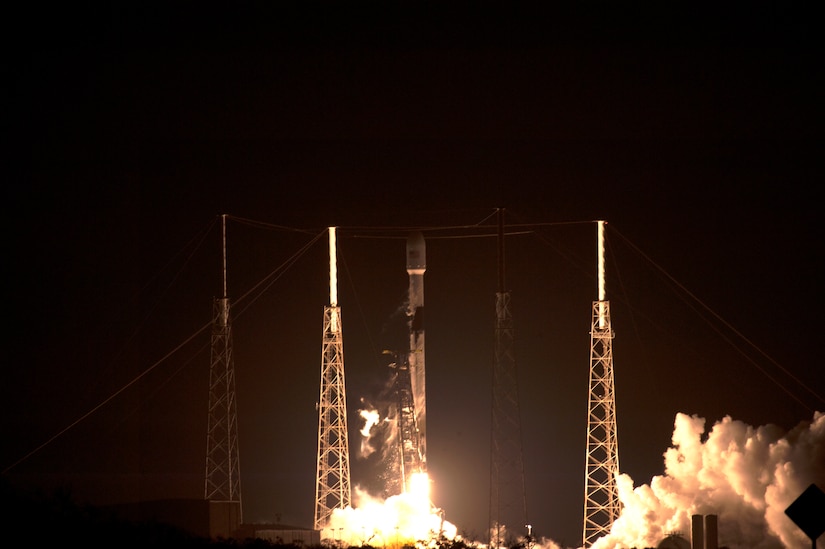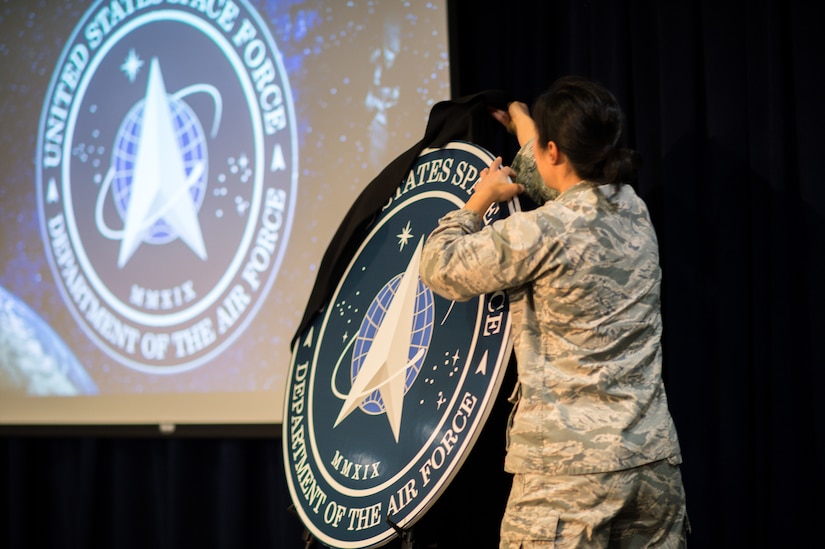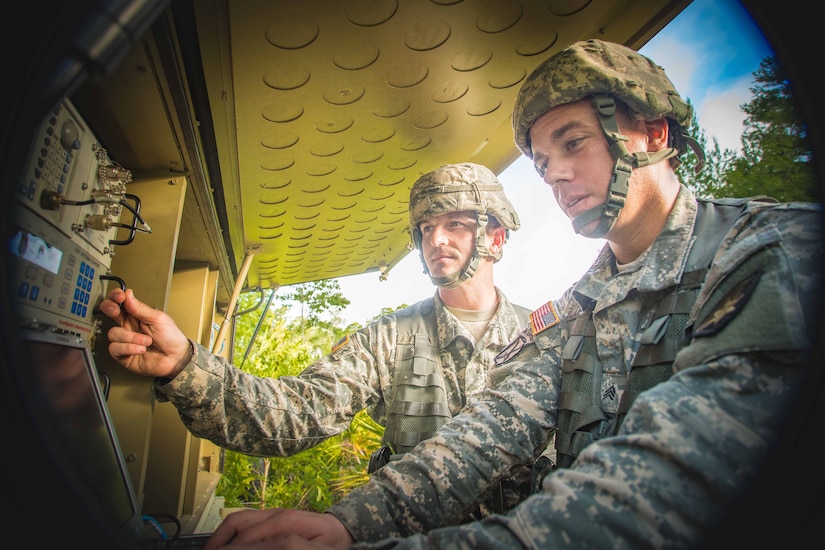Dec. 14, 2020 , DOD News
For centuries, the U.S. military has fought wars on land and sea. For that, America has the Army, the Navy and the Marine Corps. Then, in 1909, the U.S. Army bought America's first military aircraft with a $30,000 contract awarded to the Wright brothers. Less than four decades later, in 1947, the U.S. military gave birth to the U.S. Air Force to operate in the air domain.
Now, the Defense Department sees another domain beyond land, sea and air: space. To fight and win in that domain, the DOD created the U.S. Space Force, a new service, in December 2019.

The Space Force is not alone in its focus on space, however. Alongside the Space Force is the U.S. Space Command, which stood up in August 2019, and the Space Development Agency, which was created in March 2019.
All three are partners in ensuring the U.S. maintains and strengthens its leadership position in space. But all three also have different roles in that regard.
U.S. Space Force
The Space Force is the newest of the bunch, standing up in December 2019. Its current commander is Gen. John W. Raymond.
Like the Army, Navy, Air Force and Marine Corps, the Space Force is a military service, and its mission is to organize, train, equip and provide forces and capabilities to the U.S. Space Command and the other unified combatant commands around the world.
But in the same way the Marine Corps falls under the Department of the Navy rather than having its own department, the Space Force falls under the Department of the Air Force as it was originally Air Force Space Command.

Like its sister services, Space Force will recruit young men and women into service and those men and women will attend basic training and wear uniforms unique to their service.
As of late 2020, there are more than 2,000 uniformed personnel in the Space Force. As with the other services, there are civilian employees as well. About 6,000 civilian professionals are working within the Space Force.
At the same time, as a brand new service, there are individuals who are not in the Space Force, but for the time being, are assigned to it while it gets on its feet. Right now this includes about 8,000 additional military and civilian personnel.
As part of America's new focus on space, the Space Force has a mandate to be both "pathfinder and protector" of America's interests as a space-faring nation.
As the newest military service, the Space Force will partner with and lead others to further responsible actions in, and use of, space to promote security and enhance prosperity. Should an aggressor threaten U.S. interests, America's space professionals stand ready to fight and win.
U.S. Space Command
The U.S. Space Command stood up for the first time back in 1985 as a functional combatant command. In 2002, it rolled up its flag and shut its doors. At that time it'd been in existence for nearly 17 years.
On Aug. 19, 2019, however, Space Command stood up a second time. This time, Space Command is a geographic combatant command. While the U.S. European Command is meant to protect and defend U.S. interests in Europe, and U.S. Indo-Pacific Command protects and defends U.S. interests in the Pacific, U.S. Space Command protects U.S. interests in space. It's domain starts at about 60 miles above the surface of the earth and goes up from there.

Army Gen. James H. Dickinson currently serves as the commander of Space Command, which includes about 1,000 people.
Like other combatant commands, the number of personnel assigned to Space Command can shrink and grow based on the nation's needs. At the request of Space Command, and in the face of potential conflict, military services including the Army, Navy, Air Force, Marine Corps and Space Force will provide ready forces to Space Command so that it may carry out its mission to protect and defend the U.S. interests in space.
Space Command also has service components provided to it. From the Navy, there is Navy Space Command or NavSpace; from the Army, there is the Space and Missile Defense Command, or SMDC; from the Marine Corps, there is Marine Forces Space Command or MARFORSPACE; and from the Space Force, there is Space Operations Command or SpOC.

What is Space Command's mission? The command's mission focuses on four specific areas: deter aggression; defeat the nation's enemies through posture and preparedness; deliver space combat power; and defend U.S., allied and partner interests.
With warfighters represented by every service trained to seek out and deter hostile activity, Space Command is prepared to defeat threats to U.S. and allied interests. Should that deterrence fail, Space Command is ready to transition from competition to conflict and achieve space superiority.
Space Development Agency
The Space Development Agency, which stood up in March 2019, is a much, much smaller entity than either Space Force or Space Command. At about only 100 people now, and an expectation to grow to only twice that, it also has a very specific mission — but it's a big one.
The SDA, led by its director, Dr. Derek Tournear, is tasked with one thing: build the National Defense Space Architecture. When completed, the NDSA will be a collection of satellites in space — hundreds and hundreds of them — that allow for the tracking and targeting of missile threats on earth and other time-sensitive targets.
The NDSA includes seven "layers." Those are transport, tracking, custody, deterrence, navigation, battle management and support layers. The whole architecture will eventually include equipment on the ground and a lot of small satellites in low-earth orbit. Everything that makes up the NDSA, and the goal of the SDA in creating it, are focused on one thing: making sure America's warfighter has the best tools possible to do their job.

The SDA is using a "proliferation" model to build the NDSA. In the case of SDA's development of the NDSA, this means to rapidly increase the number of satellites in space every other year. SDA hopes to launch hundreds of satellites into space every two years, in tranches, and to keep doing it for a long time.
To keep the pace needed by the NDSA to design, build, procure and launch so many satellites, the SDA is relying heavily on industry and is encouraging new ways of thinking within the industry about how to provide capabilities to the government. Instead of the kinds of big contracts that end up producing things like new airplanes or carriers, SDA wants the industry to understand that there will be an ongoing market for satellites — lots of them. And that if they keep making the right kind of satellite, the SDA will likely be interested.
Tranche 0 of the NDSA, to be ready in 2022, includes 28 satellites: 20 for transport and 8 for tracking. Tranche 1, due in 2024, will include a couple hundred satellites in the transport layer, and a few dozen in the tracking layer. With Tranche 2, in 2026, the SDA would continue to build out the system as needed.

By the time Tranche 2 satellites are going up, SDA leaders say, the agency would have global coverage, ensuring that the capabilities provided by the NDSA could be available to warfighters anywhere in the world.
Ultimately, that means that the NDSA would be able to deliver information, including things like ultimately fire control solutions to the battalion level, in a very reduced timeframe over what exists today.






No comments:
Post a Comment